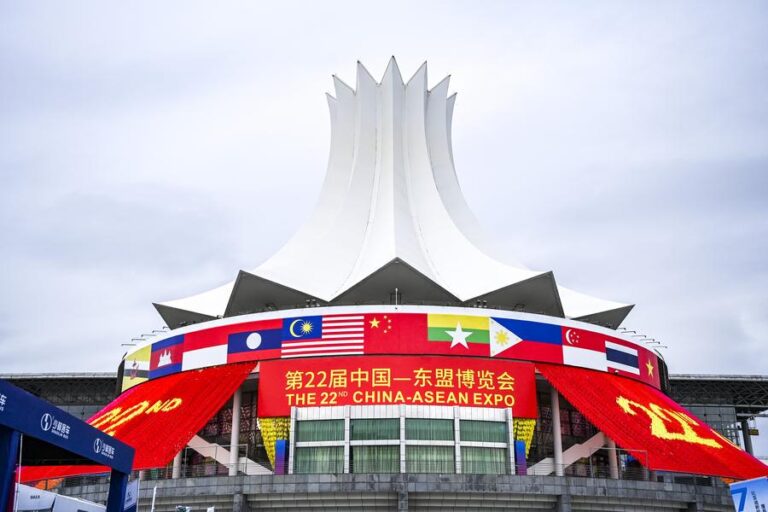* Entering its 22nd edition this year, the old-line China-ASEAN Expo for the first time set up a 10,000-square-meter pavilion dedicated to Artificial Intelligence.
* This year’s AI spotlight arrives amid the upcoming upgrade of the China-ASEAN Free Trade Area (CAFTA) to version 3.0, the world’s largest free trade zone among developing countries.
* Under strategic leadership, China and ASEAN nations are poised to deepen practical cooperation across sectors, sustaining strong trade momentum amid tech-driven shifts and CAFTA 3.0’s digital focus.
NANNING, Sept. 17 (Xinhua) — Entering its 22nd edition this year, the old-line China-ASEAN Expo (CAEXPO) for the first time set up a 10,000-square-meter pavilion dedicated to Artificial Intelligence (AI), underscoring the ever-expanding and deepening cooperation between China and the Association of Southeast Asian Nations (ASEAN).
The expo opened on Wednesday in Nanning, the capital of Guangxi Zhuang Autonomous Region in southern China. This year, it boasts an exhibition area of nearly 160,000 square meters, with over 3,200 enterprises from 60 countries participating.
AI BOOSTS PRODUCTIVITY
The AI Pavilion, the largest single-theme hall in the expo’s history, hosts nearly 200 tech firms, from industry leaders to innovative startups, showcasing nearly 1,200 AI-powered products.
This year’s AI spotlight arrives amid the upcoming upgrade of the China-ASEAN Free Trade Area (CAFTA) to version 3.0, the world’s largest free trade zone among developing countries. Negotiations concluded in May, and a formal signing is expected by the end of the year.
Version 3.0 features nine new aspects, covering digital economy, green economy and supply chain connectivity, and addressing core issues in global industrial restructuring and sustainable development. Building on the existing CAFTA and the Regional Comprehensive Economic Partnership, it enhances regulatory alignment and trade facilitation, paving the way for deeper regional integration and industrial synergy.
Standout innovations at this year’s expo include AI translation glasses, developed by Zhejiang-based Rokid, which integrate voice recognition, language processing, and real-time translation for Chinese, English, and the languages of Southeast Asia.
“Our product is drawing a huge number of on-site buyers,” said Li Zihe, a project manager at Rokid. “We are pumped about all the inquiries coming from potential ASEAN customers here at the expo as Southeast Asia has long been a target market for us.”
“This year, our roadshows across the ASEAN region have revealed a surge of interest in AI cooperation,” said Wei Zhaohui, secretary-general of CAEXPO Secretariat.
According to Wei, this year’s expo prioritizes the real-world applications of AI, encompassing manufacturing, healthcare, services, and emergency response.
In recent years, China and ASEAN have strengthened ties in AI, digital technology, green energy, smart agriculture, and supply chain digitization, leveraging geographic proximity and economic synergies to promote innovative, sustainable, and efficient development.
As ASEAN’s gateway to China, Guangxi has pioneered a cross-border industrial ecosystem by drawing on advanced R&D from major cities like Beijing, Shanghai, Guangzhou, and Shenzhen. These innovations are adapted locally and extended to ASEAN markets.
This year alone, over 200 AI firms have visited Guangxi, signing more than 70 projects valued at over 33 billion yuan (approximately 4.6 billion US dollars), with leading companies setting up ASEAN-oriented bases.
In Vientiane, the capital of Laos, construction is underway on the China-Laos AI Innovation Cooperation Center, a flagship digital project under the broader China-ASEAN collaboration. The center is designed to compile AI case studies from both regions, customizing advanced technologies to meet local needs and empowering Laotian industries.
EXPANDING TRADE TIES
Vietnam’s iconic coffee producer Trung Nguyen Legend returns with its product lineup, drawing a steady stream of crowds at the expo. Known for its signature rich chocolate-hazelnut flavor, the brand has attended every edition since the event’s debut in 2004.
From a modest 9-square-meter booth at the beginning to a spacious 54-square-meter custom display, Trung Nguyen Legend has come a long way. They have transformed their approach from just testing the waters in a traditional tea-drinking country to making big waves in the market at the expo.
In recent years, it has opened flagship stores in Shanghai and other cities, expanding sales networks with over 1,000 staff and full-blown online-offline coverage.
Bonded by close geography and cultural affinity, economic exchanges between China and ASEAN have flourished. Platforms like the CAEXPO and the China International Import Expo held annually in Shanghai have brought ASEAN’s signature offerings such as Cambodian rice, Thai latex pillows, and Lao beer to Chinese consumers, while Chinese new energy vehicles (NEV), machinery, and electronics have all found eager markets throughout ASEAN.
Under strategic leadership, China and ASEAN nations are poised to deepen practical cooperation across sectors, sustaining strong trade momentum amid tech-driven shifts and CAFTA 3.0’s digital focus.
Bilateral trade volumes have consistently risen, and for 16 consecutive years, China has been ASEAN’s leading trading partner. Meanwhile, ASEAN has held the position of China’s largest trading partner for the past five years.
Investment ties between the two economies have also grown rapidly, with accumulative two-way investment exceeding 450 billion U.S. dollars as of July this year.
Now, a new wave of investors is eyeing the potential for cooperation in digital economy, e-commerce, and green development on the back of AI-driven momentum of the new CAFTA provisions.
“Since entering ASEAN in the 1980s, our presence has expanded from ports, roads, bridges, airports, and railways to equipment manufacturing and urban development,” said Chen Zhong, vice general manager of China Communications Construction Group.
Last year, the group signed 11.68 billion U.S. dollars in new ASEAN contracts. From January to May this year, 4.72 billion U.S. dollars worth of deals were inked, according to Chen.
“Moving forward, we will align closely with each ASEAN nation’s development agenda to advance China-ASEAN infrastructure connectivity to new heights, energize regional integration and add further momentum to high-quality Belt and Road cooperation,” Chen added.
(Video reporters: Zheng Xin, Li Xiaohui, Huang Kaiying, Qin Guanghua, Liang Shun and Liu Jun; Video editors: Zhang Yucheng, Li Qin, Zhu Jianhui and Wang Han)■

